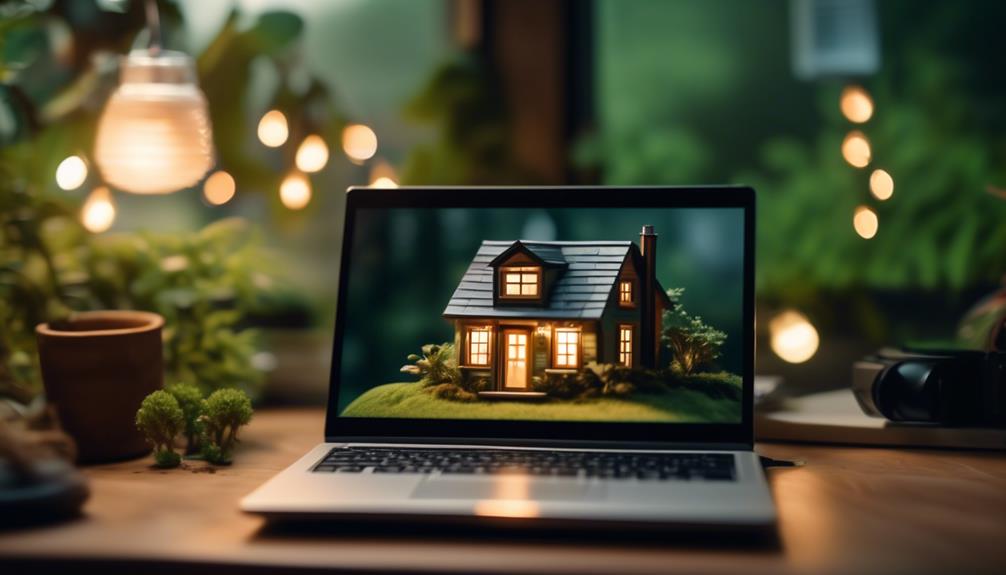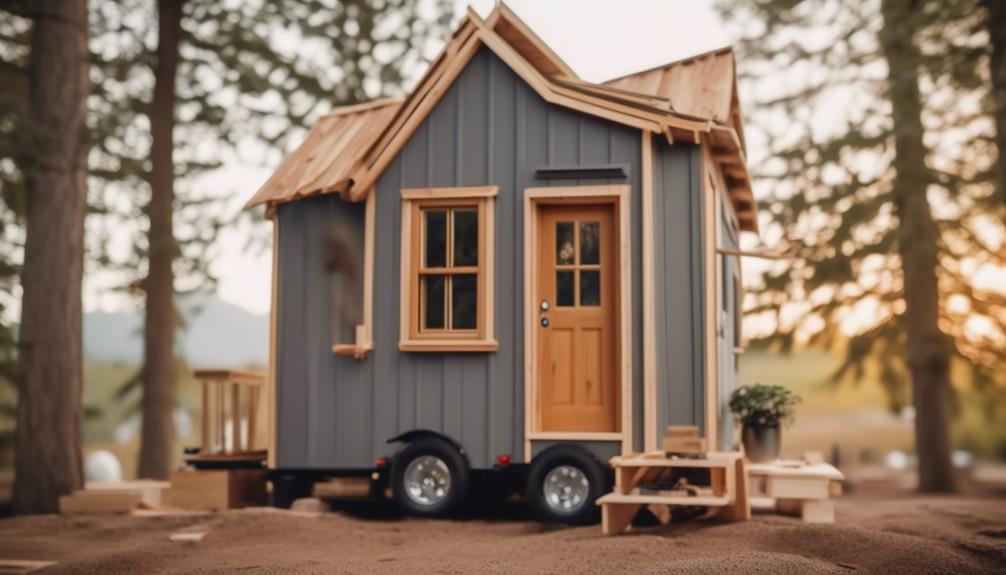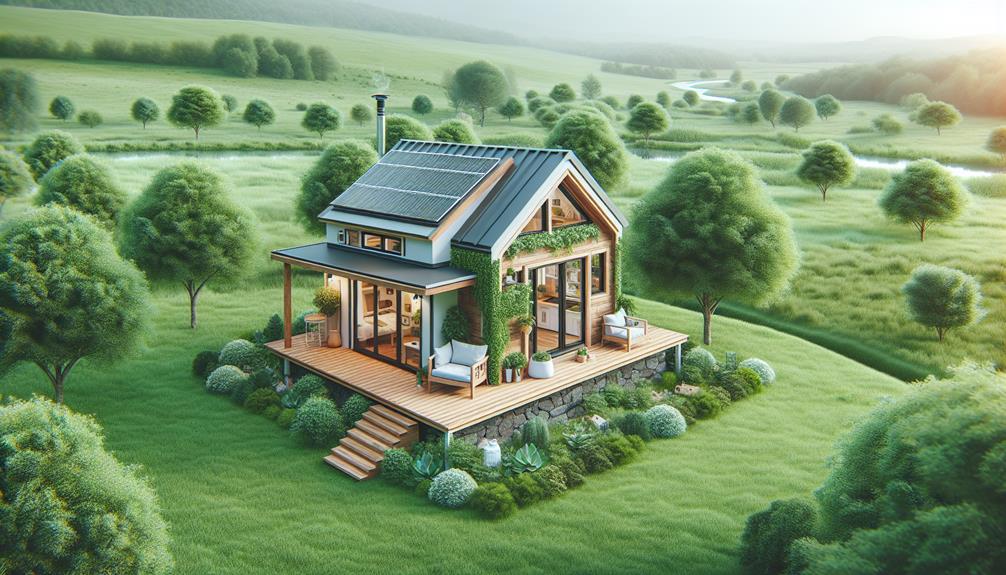So, you've always dreamed of owning a tiny house, have you? Well, lucky for you, we've got just the solution you've been searching for.
In this article, we'll show you how to take the affordable path to tiny house ownership. But here's the catch – it's not going to be easy. It's going to require some strategic planning and a bit of creativity. But trust us, the end result will be worth it.
So, are you ready to discover the secrets to making your tiny house dreams a reality? Let's get started.
Key Takeaways
- Rent to Own offers two main types: Lease Purchase and Lease Purchase, with the option to buy at the end of the time period.
- The cost of Rent to Own for a completed tiny house ranges from $20,000 to $60,000, with monthly payments varying from $120 to $460 depending on terms and cost.
- A down payment is required for Rent to Own, typically ranging from 2% to 5% of the loan amount, with a range of $500 to $3,000. Negotiating a higher down payment can be beneficial.
- Tiny house builders such as Light Stream by Sun Trust Bank, Mustard Seed Tiny Houses, Wind River Tiny Homes, Tumbleweed Tiny Houses, B&B Tiny Homes, and Corner Stone Tiny Homes offer financing options, but it's important to research their reputation and practices before committing.
How Rent to Own Works
Are you interested in learning how rent to own works for tiny house ownership? Rent to own offers a unique pathway to owning a tiny house, providing you with flexibility and affordability. Let's explore the pros and cons of rent to own contracts and how they compare to traditional home buying.
Rent to own contracts come in two main types: Lease Purchase and Lease Purchase. With Lease Purchase, you have the option to buy the tiny house at the end of the agreed time period. On the other hand, Lease Purchase requires a legal obligation to buy the tiny house at the end of the lease. It's important to carefully consider these options and choose the one that aligns with your long-term goals.
One advantage of rent to own contracts is the ability to test out the tiny house lifestyle before committing to a full purchase. This allows you to experience the benefits and challenges of tiny living without the immediate financial burden. However, it's essential to be aware of the potential downsides. Rent to own contracts often come with higher monthly payments compared to traditional home buying, as well as additional fees and requirements.
When comparing rent to own to traditional home buying, it's crucial to consider your financial situation and long-term plans. While rent to own offers more flexibility and lower upfront costs, traditional home buying provides immediate ownership and potential equity growth. It's important to weigh the pros and cons and make an informed decision based on your unique circumstances.
Cost of Rent to Own
Now let's explore the cost of rent to own contracts and how they can make tiny house ownership more affordable for you. Rent to own offers several advantages compared to traditional financing methods. Firstly, it allows you to start living in your tiny house while still making payments towards ownership. This means you can enjoy the benefits of tiny house living without having to wait until you can afford the full purchase price. Additionally, rent to own contracts often have more flexible terms and lower down payment requirements compared to traditional mortgages. However, it's important to be aware of the potential pitfalls of rent to own. For example, the total cost of the house may be higher due to interest or additional fees. It's also crucial to carefully review the terms of the contract to ensure you fully understand your obligations.
| Advantages of Rent to Own | Pitfalls of Rent to Own |
|---|---|
| Allows immediate occupancy | Higher total cost of the house |
| Flexible terms and lower down payment | Potential for additional fees |
| Enjoy the benefits of tiny house living while making payments | Obligations and terms of the contract must be carefully reviewed |
Tiny House Mortgage Calculator

Using a tiny house mortgage calculator can help you estimate the monthly payments for your future tiny house, making it easier to plan for your affordable path to tiny house ownership.
When calculating your mortgage, it's important to consider the current tiny house mortgage rates, which are usually 1-2 points higher than market rates.
Additionally, opting for shorter loan terms, such as 5, 10, or 15 years, can offer benefits such as lower interest rates and faster equity buildup.
Longer loan terms, like 20 years, are rare in the tiny house market.
Rent to Own Tiny House Shells
If you're looking for an affordable and customizable option for tiny house ownership, consider exploring the rent to own option for tiny house shells. Rent to own allows you to customize the interior of the tiny house according to your needs, making it a great choice for those who desire innovation.
One of the benefits of rent to own tiny house shells is that you have the opportunity to make the space your own, adding your personal touch and creating a home that reflects your style and preferences. However, it's important to consider the pros and cons of this option.
While rent to own provides flexibility and the ability to gradually own the house, it also requires a legal obligation to buy at the end of the lease. Additionally, the cost of completing the tiny house can range from $20,000 to $60,000, with monthly payments varying between $120 and $460.
Researching reputable builders that offer finance options is crucial before committing to a rent to own agreement.
Tiny House Builders That Offer Finance

Consider exploring reputable tiny house builders that offer finance options to make your dream of tiny house ownership a reality. These builders understand the growing demand for affordable housing solutions and have developed financing programs to help you achieve your goals.
When exploring the financing process, it's important to carefully review the terms and conditions offered by each builder. Look for competitive interest rates, flexible repayment options, and reasonable down payment requirements. Some builders may even offer the option to customize your financing plan to fit your specific needs.
Researching Financing Options
Looking to explore your options for financing a tiny house? Here are some key factors to consider:
- Pros and cons of renting to own a tiny house:
- Pros: Allows you to live in and experience a tiny house before committing to purchase, flexibility in terms of lease duration, and potential for building equity.
- Cons: Higher monthly payments compared to traditional renting, limited options for customization, and the possibility of not being able to secure financing at the end of the lease.
- Tips for improving credit score to qualify for financing a tiny house:
- Pay bills on time to establish a positive payment history.
- Keep your credit utilization ratio low by using only a small portion of your available credit.
- Reduce your overall debt by paying off existing loans or credit card balances.
Frequently Asked Questions
Are There Any Additional Costs or Fees Associated With the Rent-To-Own Process Besides the Down Payment and Monthly Payments?
When considering rent-to-own, it's important to know that besides the down payment and monthly payments, there may be additional costs and hidden fees. Research and ask about any potential expenses before committing to a lease.
What Happens if I Decide I No Longer Want to Buy the Tiny House at the End of the Lease Period?
If you decide not to buy the tiny house at the end of the lease, you have options. You can negotiate a different agreement, terminate the rent-to-own process, or explore other housing options.
Can I Make Modifications or Renovations to the Tiny House if I Am Renting to Own It?
Yes, you can make modifications and renovations to the tiny house if you are renting to own it. This allows you to customize the space according to your needs and make it truly your own.
Are There Any Restrictions on Where I Can Park or Place the Tiny House While I Am Renting to Own It?
You'll be happy to know that there are usually no restrictions on where you can park or place your tiny house while renting to own it. However, it's important to check local zoning regulations to ensure compliance.
What Happens if There Are Repairs or Maintenance Issues With the Tiny House During the Rental Period?
If there are repairs or maintenance issues with the tiny house during the rental period, it is important to communicate with the landlord or the company providing the rent-to-own agreement. They should be responsible for addressing and resolving these issues promptly.
Conclusion
In conclusion, rent to own offers an affordable path to tiny house ownership. With the option to gradually work towards owning your dream home, you can experience the freedom and simplicity that comes with living in a space tailored to your needs.
By researching financing options, using a tiny house mortgage calculator, and exploring reputable builders that offer finance, you can make your dreams of owning a tiny house a reality.
Remember, 'Home is where the heart is' and with rent to own, your heart can truly find its home.

